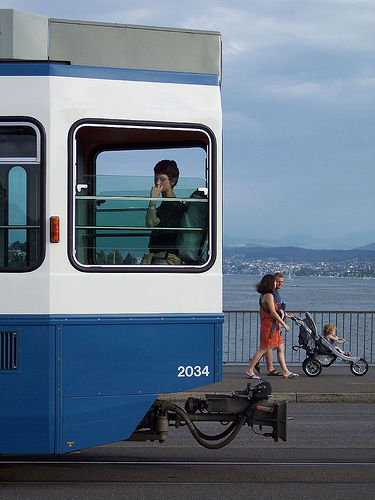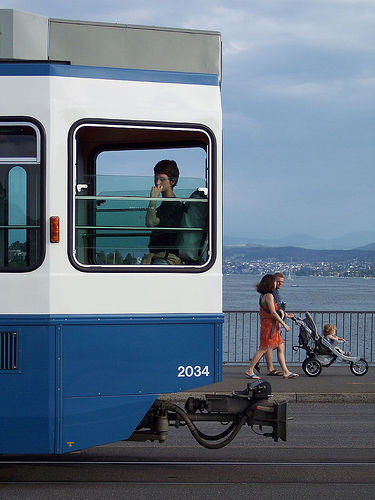 In Zurich, trams and pedestrians take precedence over cars.Photo: iwouldstayThere’s a fascinating piece in today’s New York Times about the thinking and methodology behind some of Europe’s most progressive transportation policies.
In Zurich, trams and pedestrians take precedence over cars.Photo: iwouldstayThere’s a fascinating piece in today’s New York Times about the thinking and methodology behind some of Europe’s most progressive transportation policies.
It’s got kind of an unfortunate headline: “Europe Stifles Drivers in Favor of Alternatives.” (In the print edition, where the story had top billing on the front page, it was “Across Europe, Irking Drivers Is Urban Policy”.) But let’s put that aside for the moment.
The Times piece catalogs the multiple disincentives to driving in European cities, including limits on parking, congestion pricing, restrictions on cars in center cities, and decent public transit and bike infrastructure.
Why are so many European cities doing these things? Because they realize that continuing to build a transport system around the automobile is unsustainable in pretty much every way.
Europe’s cities generally have stronger incentives to act. Built for the most part before the advent of cars, their narrow roads are poor at handling heavy traffic. Public transportation is generally better in Europe than in the United States, and gas often costs over $8 a gallon, contributing to driving costs that are two to three times greater per mile than in the United States, Dr. Schipper said.
What is more, European Union countries probably cannot meet a commitment under the Kyoto Protocol to reduce their carbon dioxide emissions unless they curb driving. The United States never ratified that pact.
Globally, emissions from transportation continue a relentless rise, with half of them coming from personal cars….
European cities also realized they could not meet increasingly strict World Health Organization guidelines for fine-particulate air pollution if cars continued to reign. Many American cities are likewise in “nonattainment” of their Clean Air Act requirements, but that fact “is just accepted here,” said [Michael Kodransky, global research manager at the Institute for Transportation and Development Policy in New York.]
Let’s imagine flipping this thing around. What about an article headlined “U.S. Stifles Transit in Favor of Cars,” or “Across the U.S., Irking Pedestrians Is Urban Policy.” You probably won’t see those in the Times, but that is what we do here. We starve transit systems, denying them adequate funding. As a result, they are often unreliable and unattractive. We also build streets that are blatantly unfit for human presence, then blame people for problems that occur when they try to cross them.
The Times piece itself could have just as easily been titled “Europe Encourages Alternatives to Driving.” By adequately funding public transit and creating safe places for people to walk and bike, that’s what so many of the continent’s cities are doing.
No one is being stifled — because drivers are just people who happen to be driving cars. When they get out of those cars, they are no longer drivers. They are pedestrians, as all of us are at some point. They are transit riders, like 91 percent of the Swiss Parliament. They are also people who breathe air, the befouling of which is accepted in this country with a shrug, in the name of automobility.
The comments section of the Times is loaded with people who protest that these European policies could never work in the U.S. because we are such a big country. All that wide-open space, and stuff.
But there are dozens, if not hundreds, of American cities that could easily incorporate more pedestrian- and transit-friendly policies. And yet even in New York City, with the lowest car ownership rates in the nation, it is a struggle to take a single inch away from cars.
Although the idea of prioritizing pedestrians might seem like crazy talk in the U.S., in Zurich it’s just common sense:
With politicians and most citizens still largely behind them, Zurich’s planners continue their traffic-taming quest, shortening the green-light periods and lengthening the red with the goal that pedestrians wait no more than 20 seconds to cross.
“We would never synchronize green lights for cars with our philosophy,” said Pio Marzolini, a city official. “When I’m in other cities, I feel like I’m always waiting to cross a street. I can’t get used to the idea that I am worth less than a car.”
You know what? He isn’t worth less than a car. Neither are you.



